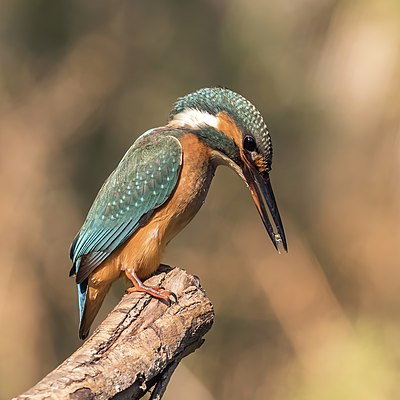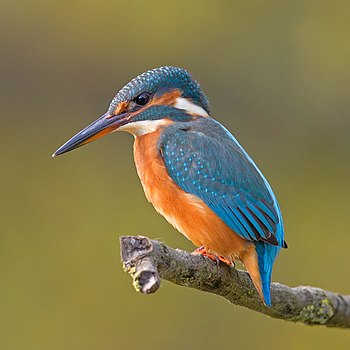Talk:Common kingfisher
| This article is rated B-class on Wikipedia's content assessment scale. It is of interest to the following WikiProjects: | |||||||||||||||||||||||||||||||||||||||||
| |||||||||||||||||||||||||||||||||||||||||
Title Change and Redirects
[edit]After the title change, I went through the list WhatLinksHere to fix double redirects. Out of the first 100 pages I visited, no more than 10 or 15 mentioned the name "European"; and a handful mentioned "Eurasian". All the rest were existing double redirects, being links to Common Kingfisher, which now became direct links.
Unfortunately the talk pages for European Kingfisher, with the justification for the title change, remains at Talk:European Kingfisher since CK already had a talk page. mukerjee (talk) 04:00, 25 April 2007 (UTC)
Eggs
[edit]"but the six to seven or even more round white eggs are placed on a litter of fish bones and disgorged pellets. The eggs are pink"
Er...? 85.158.137.195 11:40, 25 April 2007 (UTC)
?????
Tushar Gulve (talk) 14:29, 24 January 2019 (UTC)
Range map
[edit]I could remove the Kingfisher image in the corner of the map and change the orange to yellow. What is the best appearance which is consistent with other range maps? If the cropped map is no longer needed, I will mark is for deletion on commons as it has been superseded by the full map. Snowman (talk) 11:00, 22 August 2008 (UTC)
- please don't - I created the new version because I didn't want the German text, the little kingfisher in the corner, or the Americas, where this species doesn't occur. I just wanted to check the summary was correct. I like the improved legend though. the colour scheme is standard insofar as there is a standard - used in most books, (except those that use red-purple-blue)jimfbleak (talk) 13:04, 22 August 2008 (UTC)
- But the cropped map looks odd, partly because it cuts through the top of Australia. The new map had English text and I can remove the kingfisher in the corner. The German Featured Article has a complete map. Snowman (talk) 13:24, 22 August 2008 (UTC)
- This is a complete map of the species' range, I don't know why the German editor chose to have a world map, it's more usual to have just the continent or continents that are relevant. Puerto Rican Amazon just shows the island, not a dot on a world map. I take the point about Australia, though, maybe the solution is a map with just the Americas cropped? Or recrop this one just above Oz? jimfbleak (talk) 15:23, 22 August 2008 (UTC)
- One other problem with a whole-world map is that it's long and thin, so either the actual range is compressed or the taxobox has to be widened. jimfbleak (talk) 15:27, 22 August 2008 (UTC)
- This is a complete map of the species' range, I don't know why the German editor chose to have a world map, it's more usual to have just the continent or continents that are relevant. Puerto Rican Amazon just shows the island, not a dot on a world map. I take the point about Australia, though, maybe the solution is a map with just the Americas cropped? Or recrop this one just above Oz? jimfbleak (talk) 15:23, 22 August 2008 (UTC)
- But the cropped map looks odd, partly because it cuts through the top of Australia. The new map had English text and I can remove the kingfisher in the corner. The German Featured Article has a complete map. Snowman (talk) 13:24, 22 August 2008 (UTC)
- please don't - I created the new version because I didn't want the German text, the little kingfisher in the corner, or the Americas, where this species doesn't occur. I just wanted to check the summary was correct. I like the improved legend though. the colour scheme is standard insofar as there is a standard - used in most books, (except those that use red-purple-blue)jimfbleak (talk) 13:04, 22 August 2008 (UTC)
- It also cuts through Africa which looks odd. I think that it would be better to include Australia and the South of Africa. Should the orange areas be yellow?
- Well, like I said, I don't think the Americas should be there, but i don't really mind otherwise. Yellow is more common, but I just stuck with the German colouring. I don't mind whether it's yellow or orange myself, as long as the legend matches. Maps are rarely an issue at GA/FA since they are not actually a requirement. jimfbleak (talk) 19:24, 22 August 2008 (UTC)
- On a completely unrelated issue, FAC has been struggling a bit recently with finding people to check image licences - I don't know whether that interests you? jimfbleak (talk) 19:24, 22 August 2008 (UTC)
- Did you notice I removed the watermarks from the images within the main text? Snowman (talk) 19:38, 22 August 2008 (UTC)
- No, I didn't - well done. I'm still in the process of sorting out what images to use, what I normally do is dump the gallery when I've nearly finished, but the ones currently in the text are likely to remain. jimfbleak (talk) 06:00, 23 August 2008 (UTC)
- Map with all of Australia and Africa, and cropped without the new world and without German textboxes. Orange changed to yellow in new map. Snowman (talk) 10:54, 23 August 2008 (UTC)
- You're right, does look better cropped as is at present, thanks jimfbleak (talk) 06:45, 24 August 2008 (UTC)
- Map with all of Australia and Africa, and cropped without the new world and without German textboxes. Orange changed to yellow in new map. Snowman (talk) 10:54, 23 August 2008 (UTC)
- No, I didn't - well done. I'm still in the process of sorting out what images to use, what I normally do is dump the gallery when I've nearly finished, but the ones currently in the text are likely to remain. jimfbleak (talk) 06:00, 23 August 2008 (UTC)
- Did you notice I removed the watermarks from the images within the main text? Snowman (talk) 19:38, 22 August 2008 (UTC)
- On a completely unrelated issue, FAC has been struggling a bit recently with finding people to check image licences - I don't know whether that interests you? jimfbleak (talk) 19:24, 22 August 2008 (UTC)
- Well, like I said, I don't think the Americas should be there, but i don't really mind otherwise. Yellow is more common, but I just stuck with the German colouring. I don't mind whether it's yellow or orange myself, as long as the legend matches. Maps are rarely an issue at GA/FA since they are not actually a requirement. jimfbleak (talk) 19:24, 22 August 2008 (UTC)
How come Saudi Arabia isn't included in the map when there are common kingfishers there?Chandra.tap (talk) 09:13, 26 August 2008 (UTC)
- the map is from the German FA.jimfbleak (talk) 12:16, 26 August 2008 (UTC)
- And there is quite a lot of blue in Saudi Arabia on the range map. Snowman (talk) 13:53, 26 August 2008 (UTC)
- Quite right, I never thought to check if the statement above was actually correct jimfbleak (talk) 14:43, 26 August 2008 (UTC)
- And there is quite a lot of blue in Saudi Arabia on the range map. Snowman (talk) 13:53, 26 August 2008 (UTC)
- the map is from the German FA.jimfbleak (talk) 12:16, 26 August 2008 (UTC)
South Aftrica???
[edit]Under Habitat and distribution it says "Also found in the Western Cape of South Africa". It is not mentioned in my third edition of Birds of Southern Africa (Sinclair, Hockey, Tarboton 2002), Robert's Birds or South Africa (McLachlan & Liversidge 1980) nor Birds of the Southern Third of Africa (Mackworth-Praed & Grant 1962). Although I strongly doubt the truth of the statement (I doubt there are any accepted observations south of Sahara at all) I marked it with "Citation needed". (The statement was added by Gorillaza on 9 Feb 2011.)
--Episcophagus (talk) 21:02, 12 April 2012 (UTC)
- It's obviously wrong, could well have been a GF edit by someone who had seen a similar SA species like Malachite or Half-collared. Removed Jimfbleak - talk to me? 05:40, 13 April 2012 (UTC)
File:Common Kingfisher Alcedo atthis.jpg to appear as POTD soon
[edit]Hello! This is a note to let the editors of this article know that File:Common Kingfisher Alcedo atthis.jpg will be appearing as picture of the day on December 17, 2015. You can view and edit the POTD blurb at Template:POTD/2015-12-17. If this article needs any attention or maintenance, it would be preferable if that could be done before its appearance on the Main Page. — Chris Woodrich (talk) 01:05, 29 November 2015 (UTC)
Featured picture scheduled for POTD
[edit]Hello! This is to let editors know that File:Common kingfisher (Alcedo atthis ispida) female.jpg, a featured picture used in this article, has been selected as the English Wikipedia's picture of the day (POTD) for October 2, 2022. A preview of the POTD is displayed below and can be edited at Template:POTD/2022-10-02. For the greater benefit of readers, any potential improvements or maintenance that could benefit the quality of this article should be done before its scheduled appearance on the Main Page. If you have any concerns, please place a message at Wikipedia talk:Picture of the day. Thank you! Adam Cuerden (talk)Has about 7.9% of all FPs 11:48, 1 June 2022 (UTC)

|
The common kingfisher (Alcedo atthis), also known as the Eurasian kingfisher or the river kingfisher, is a small species of kingfisher with seven subspecies recognized within its wide distribution across Eurasia and northern Africa. It is resident in much of its range, but migrates from areas where rivers freeze in winter. Like all kingfishers, the common kingfisher is highly territorial; since it must eat around 60 per cent of its body weight each day, it is essential to have control of a suitable stretch of river. It is solitary for most of the year, roosting alone in heavy cover. If another kingfisher enters its territory, both birds display from perches, and fights may occur, in which a bird will grab the other's beak and try to hold it underwater. Pairs form in the autumn but each bird retains a separate territory, generally at least 1 km (0.6 mi) long but up to 3.5 km (2.2 mi), and territories are not merged until the spring. This female common kingfisher, of the subspecies A. a. ispida, was photographed near Kecskemét in Hungary. Photograph credit: Charles J. Sharp
Recently featured:
|
- B-Class bird articles
- Low-importance bird articles
- WikiProject Birds articles
- B-Class Africa articles
- Unknown-importance Africa articles
- WikiProject Africa articles
- B-Class Asia articles
- Unknown-importance Asia articles
- WikiProject Asia articles
- B-Class Europe articles
- Unknown-importance Europe articles
- WikiProject Europe articles
- B-Class Oceania articles
- Unknown-importance Oceania articles
- WikiProject Oceania articles






